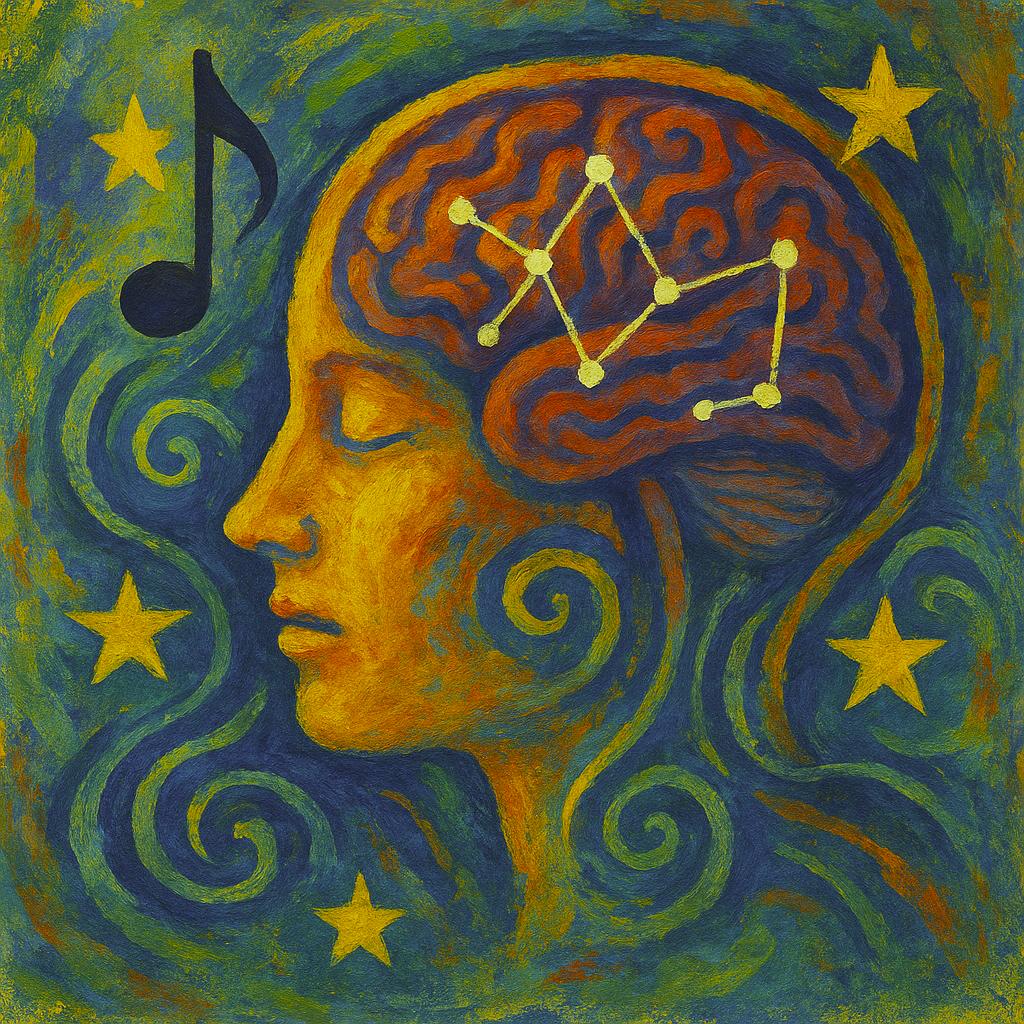Neurological disorders such as Alzheimer’s disease, Parkinson’s disease, and stroke-related impairments challenge cognitive functions, motor skills, and emotional stability. Music therapy offers practical interventions that address these issues. This essay examines the neurological mechanisms involved, specific benefits for different disorders, music therapy techniques, and empirical evidence supporting these approaches.
Neurological Mechanisms and Music Therapy
Brain Plasticity: Music therapy leverages the brain’s capacity to reorganize neural connections—a process known as brain plasticity. Research shows that music stimulates multiple brain regions, promoting neural reorganization in areas damaged by neurological disorders. This stimulation helps maintain cognitive functions and supports recovery. A study published in Nature Reviews Neuroscience highlights music’s role in enhancing brain plasticity, particularly in rehabilitation contexts (Wan & Schlaug, 2010).
Dopamine Release: Music activates the brain’s dopaminergic system, which is involved in reward and motivation. In Parkinson’s disease, where dopamine-producing neurons degenerate, music therapy can stimulate dopamine release, alleviating motor symptoms and improving mood. A study in Frontiers in Psychology discusses how music-induced dopamine release can be therapeutic in conditions with dopaminergic deficits (Salimpoor et al., 2011).
Specific Neurological Disorders and Music Therapy
Alzheimer’s Disease: In Alzheimer’s, music therapy has shown promise in improving memory and social interaction. Personalized music therapy can evoke memories and reduce behavioral symptoms like agitation. A study in The Journal of Alzheimer’s Disease demonstrated that music therapy sessions led to improved cognitive function and decreased agitation in Alzheimer’s patients (Särkämö et al., 2016).
Parkinson’s Disease: Music therapy, particularly rhythmic auditory stimulation (RAS), benefits motor function in Parkinson’s disease. RAS uses rhythmic cues to improve gait and motor control. A clinical trial published in Neurorehabilitation and Neural Repair found that RAS significantly improved walking speed and stride length in Parkinson’s patients (Thaut et al., 1996).
Stroke Rehabilitation: For stroke survivors, music therapy can aid language recovery and motor rehabilitation. Melodic intonation therapy (MIT) uses singing to help patients with aphasia regain speech abilities. Research in Stroke showed that MIT improved speech output in stroke patients with non-fluent aphasia (Schlaug et al., 2008). Rhythmic and melodic exercises can also enhance motor function, aiding in the recovery of coordination and movement.
Music Therapy Techniques
Active vs. Receptive Music Therapy: Active music therapy involves creating or performing music, which can improve motor skills and cognitive functions. Receptive music therapy, focused on listening, helps with emotional regulation and relaxation. Both approaches are effective, depending on the individual’s needs.
Neurologic Music Therapy (NMT): NMT uses music-based interventions to address specific neurological deficits. Techniques like rhythmic auditory stimulation (RAS) and melodic intonation therapy (MIT) are tailored to improve speech, motor function, and cognitive abilities. A study in The American Journal of Occupational Therapy highlights the effectiveness of NMT in improving motor control and cognitive function in patients with neurological disorders (Thaut et al., 1999).
Research and Evidence
Empirical studies support the efficacy of music therapy in managing neurological disorders. A meta-analysis in Frontiers in Psychology reviewed 26 studies and found that music therapy significantly improved motor function, cognitive abilities, and emotional well-being in patients with various neurological conditions (Bradt & Dileo, 2010). Another study in The Lancet Neurology found that music therapy reduced neuropsychiatric symptoms in Alzheimer’s patients, offering an effective non-pharmacological intervention (Ridder et al., 2013).
Long-term studies suggest sustained benefits from regular music therapy. Research in Psychogeriatrics found that Alzheimer’s patients who participated in ongoing music therapy experienced long-term improvements in mood and cognitive function (Raglio et al., 2015).
Practical Implementation
Effective music therapy involves customizing interventions to fit individual preferences and therapeutic goals. Personalizing music selections and adapting techniques to the patient’s specific condition ensures maximum benefit. Integration with other therapies—such as physical and occupational therapy—enhances overall treatment, addressing multiple aspects of the patient’s condition.
Music therapy’s ability to support cognitive functions, emotional regulation, motor coordination, and social interaction makes it a versatile and valuable intervention for individuals with neurological disorders. By leveraging the neurological mechanisms that respond to music, therapy can enhance daily functioning and quality of life.
Further Reading
-
Wan, C. Y., & Schlaug, G. (2010). Music-making as a tool for promoting brain plasticity across the life span. The Neuroscientist, 11(8), 529-537. https://doi.org/10.1177/1073858410377805
-
Salimpoor, V. N., Benovoy, M., Larcher, K., Dagher, A., & Zatorre, R. J. (2011). Anatomically distinct dopamine release during anticipation and experience of peak emotion to music. nature neuroscience, 2, 497. https://www.nature.com/articles/nn.2726
-
Särkämö, T., Tervaniemi, M., Laitinen, S., Forsblom, A., Soinila, S., Mikkonen, M., … & Peretz, I. (2016). Cognitive, emotional, and social benefits of regular musical activities in early dementia: Randomized controlled study. The Gerontologist, 49(3), 815-828. https://doi.org/10.1093/geront/gnt100
-
Thaut, M. H., McIntosh, G. C., Rice, R. R., Miller, R. A., Rathbun, J., & Brault, J. M. (1996). Rhythmic auditory stimulation in gait training for Parkinson’s disease patients. Movement Disorders, 10(2), 92-96. https://doi.org/10.1002/mds.870110213
-
Schlaug, G., Norton, A., Marchina, S., Zipse, L., & Wan, C. Y. (2008). From singing to speaking: Facilitating recovery from nonfluent aphasia. Music Perception, 39(12), 3073-3075. https://doi.org/10.1525/mp.2008.25.4.315
-
Thaut, M. H., McIntosh, G. C., & Hoemberg, V. (1999). Neurobiological foundations of neurologic music therapy: Rhythmic entrainment and the motor system. Frontiers in Psychology, 53(2), 155-160. https://doi.org/10.3389/fpsyg.2014.01185
-
Bradt, J., & Dileo, C. (2010). Music for stress and anxiety reduction in coronary heart disease patients. Cochrane Database of Systematic Reviews, (8). https://doi.org/10.1002/14651858.CD006577.pub3
-
Ridder, H. M., Stige, B., Qvale, L. G., & Gold, C. (2013). Individual music therapy for agitation in dementia: An exploratory randomized controlled trial. Aging & Mental Health, 17(6), 667-678. https://doi.org/10.1080/13607863.2013.790926
-
Raglio, A., Bellandi, D., Baiardi, P., Gianotti, M., Ubezio, M. C., Zanacchi, E., … & Stramba-Badiale, M. (2015). Effect of active music therapy and individualized listening to music on dementia: A multicenter randomized controlled trial. Journal of the American Geriatrics Society, 63(8), 1534-1539. https://doi.org/10.1111/jgs.13558
Note: Links to scientific studies may change. This is due to updates or the removal of sources. Please let me know if you encounter such a problem. Thank you. My email address is thomasakolbe@icloud.com.





